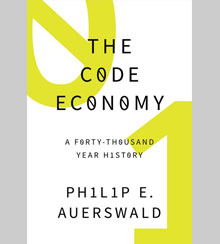strategy+business, May 24, 2017
by Theodore Kinni
Jobs are the burning issue of the day. But while politicians are busy erecting physical, economic, and rhetorical walls to corral and preserve jobs, a larger and more fundamental question looms. As advances in artificial intelligence and machine learning permeate every industry, will there be any jobs left to protect?
Philip E. Auerswald, associate professor at George Mason University’s Schar School of Policy and Government, calls this question “The Great Man–Machine Debate.” In his engaging and wide-ranging book, The Code Economy: A Forty-Thousand-Year History, he seeks to answer it by reframing how we think about economic dynamics and progress. “The microeconomics you learned in college was generally limited to the ‘what’ of production: what goes in and what comes out,” Auerswald writes. “This book is about the ‘how’: how inputs are combined to yield outputs.”
Auerswald has a more expansive definition of the word code than the typical computer scientist. For him, code encapsulates the how of production — that is, the technology and the instruction sets that guide production. The processes Paleolithic peoples used to create stone tools, the punch cards that Joseph Marie Jacquard used to direct looms in France in the early 1800s, Henry Ford’s assembly lines, and the blockchains first described by the person (or persons) named Satoshi Nakamoto in 2008: All these are, in Auerswald’s view, examples of code. Read the rest here.
Philip E. Auerswald, associate professor at George Mason University’s Schar School of Policy and Government, calls this question “The Great Man–Machine Debate.” In his engaging and wide-ranging book, The Code Economy: A Forty-Thousand-Year History, he seeks to answer it by reframing how we think about economic dynamics and progress. “The microeconomics you learned in college was generally limited to the ‘what’ of production: what goes in and what comes out,” Auerswald writes. “This book is about the ‘how’: how inputs are combined to yield outputs.”
Auerswald has a more expansive definition of the word code than the typical computer scientist. For him, code encapsulates the how of production — that is, the technology and the instruction sets that guide production. The processes Paleolithic peoples used to create stone tools, the punch cards that Joseph Marie Jacquard used to direct looms in France in the early 1800s, Henry Ford’s assembly lines, and the blockchains first described by the person (or persons) named Satoshi Nakamoto in 2008: All these are, in Auerswald’s view, examples of code. Read the rest here.
















No comments:
Post a Comment